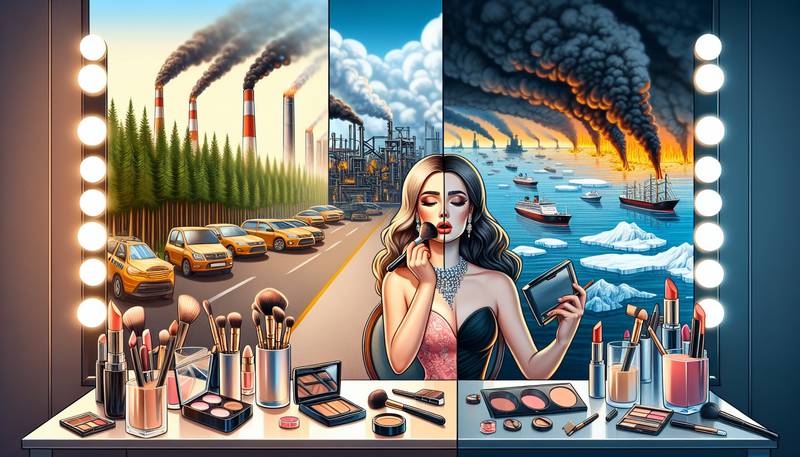Number of listings removed from our directory since 1st November 2019 = 1269
|
The Beauty Industry's Role in Climate Change: A Glamorous Catastrophe

Cosmetics or Catastrophe?It seems like every time you turn around, there's a new beauty product promising to enhance your glow while simultaneously dimming the lights on our planet. With formulations that could rival the complexity of rocket science, consumers are often left wondering if their favorite foundation is more likely to cover imperfections or contribute to the next climate conference's list of woes. It’s a tough call—like choosing between chocolate and a Netflix binge.The beauty industry whips up millions of products every year, all while the earth is over here struggling with pollution like it’s auditioning for a disaster film. One has to wonder—if mascara can lengthen lashes, can it also stretch the limits of our environment?Ingredients That Raise EyebrowsWhen delving into the ingredient list of beauty products, one might stumble across mystical-sounding components. Ever heard of 'unicorn tears' or 'mermaid scales'? While those may be just for show, some ingredients actually pose a real threat to our oceans and forests. Consider palm oil, for instance. It lurks in many cosmetics, often disguised under vague terms while taking a toll on biodiversity. Picture a rainforest waving goodbye as it’s bulldozed for our favorite moisturizers. It’s like shedding tears over an Instagram photo—unproductive and a little tragic.- Sodium Lauryl Sulfate: Sounds fancy, right? It’s in everything from shampoo to toothpaste and is notorious for polluting waterways.
- Fragances: They might smell like a garden in spring but could include chemicals that harm the environment.
- Microbeads: Tiny little buggers that scrub your face clean but end up as uninvited guests in marine life.
Packaging: The Unboxing DilemmaIf you thought choosing between a matte or dewy finish was frustrating, wait until you confront the deluge of packaging flying around the beauty aisle. For every product that promises to make you look radiant, it's likely wrapped in a generous layer of plastic that could rival an ancient mummy. Who knew achieving a 'natural' look could produce so much waste?Innovations such as refillable containers are a step in the right direction, offering consumers the chance to save the planet one lipstick tube at a time. However, just because something is labeled 'eco-friendly' doesn’t mean it’s guilt-free. It's a bit like a wolf in sheep's clothing—adorable, but you definitely don't want it near your skincare routine.Greenwashing: The Beauty Industry’s Best Kept SecretWith climate-conscious consumers on the rise, beauty brands have embraced greenwashing like a cat snuggling into a sunbeam. They make lofty claims about sustainability while leaving their eco-footprint behind like breadcrumbs. It seems like every other day a brand announces that its new line is made from recycled materials or is “totally plant-based” (which, let’s be honest, sounds more like a trendy diet than a product line). But looking deeper often reveals that the products are as sustainable as a paper straw in a hurricane.- Fluffy claims: Terms like 'natural' or 'organic' can be as misleading as a magician's flourish.
- Clever marketing: Watch out for terms that sound impressive but mean absolutely nothing.
- Underwhelming efforts: Sometimes it takes more than a green logo to make a difference.
Serious Business: Diving DeeperThe impact of the beauty industry on climate change is a multifaceted issue that demands a serious approach. Consumption patterns, manufacturing processes, and waste management all play roles in determining the ecological footprint of beauty products. Transitioning to sustainably sourced ingredients and reducing harmful emissions are essential if the industry wants to become part of the solution rather than part of the problem.It’s time for brands to step up and take responsibility, reducing their environmental impact through innovative practices rather than marketing tricks. When the Makeup Comes OffAt the end of the day, beauty shouldn’t come at the expense of the planet. The industry holds immense potential to drive change, whether through eco-friendly practices or by embracing transparency in sourcing.Let’s face it—if Mother Nature had a beauty routine, it would probably involve less plastic and a lot more compassion. Reducing our collective carbon footprint could be the most fashionable thing we do. After all, nothing looks better than a thriving planet that feels like a runway. If the beauty industry wants to truly shine, embracing sustainability is not just a “must-have”; it’s the new black.
|
|
|







